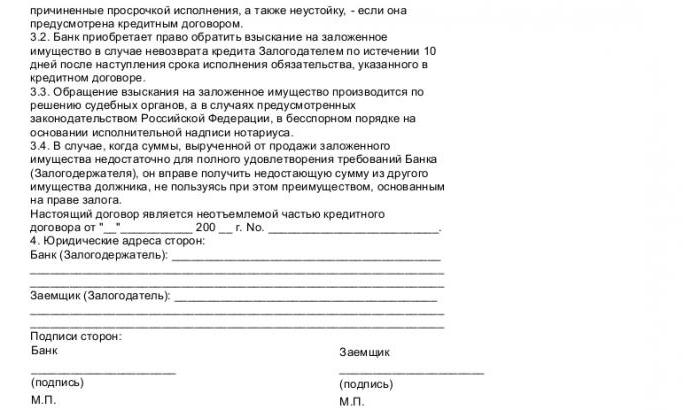Under the pledge of goods in circulation, it should be understood the pledge of commercial products with their immediate leaving to the pledger, provided that the latter has the right to change the natural form and composition of the pledged property (raw materials, stocks of commercial products, semi-finished products, materials, finished product). It is important to note that the total cost of the presented elements cannot be less than determined by means of a pledge agreement in accordance with the first paragraph of Article 357 of the Civil Code. How widespread is the application of this type of collateral in economic practice? Why? What characteristics define such categories as a pledge of goods in circulation and a pledged item? You can find answers to these and other equally interesting questions in the process of familiarization with the materials of this article.
Category Occurrence
The pledge of goods in circulation was first mentioned in the days of Ancient Rome. Thus, the well-known lawyer Stsevole received a specific question. He consisted in the fact that the debtor pledged a shop to the creditor, after which he asked if nothing had happened as a consequence or if it was necessary to put up with the fact that under the name of the shop, one way or another, the commodity products that were in the shop were pledged .

In addition, the question was as follows: if the debtor sold these goods at different times of the year and purchased others, and placed the latter directly in the shop, after which he died, is the creditor entitled to demand all that is in the shop through a mortgage suit, because items that were included in the composition of commodity products are sold, and other things are placed in the shop.
Stcevola responded to such an appeal: “Things and values that will be in the shop at the time of the debtor’s death belong to the mortgaged.” So, in his answer you can find absolutely all the necessary features of the pledge of goods in circulation. Among them are the following items:
- Generic characteristics of the subject of pledge.
- Setting the distribution time in relation to the newly received goods regarding the security right.
- The right of the pledgor to replace things that, one way or another, are included in the subject of the pledge.
- The certainty of the location of marketable products.
It is important to note that the replica of Stcevola on the pledge of goods in circulation is included in the codification of Ancient Rome, which is today truly outstanding - Digesta Justinian.
The essence of the concept
In this chapter, it will be advisable to fully consider the essence of the concept relevant to the article. So, under the pledge of goods in circulation, it should be understood the method of security named in the current Civil Code, according to which the pledged commercial products, one way or another, remain with the pledger.

It must be added that the latter has the right to change the natural form and composition of the mortgaged property. This includes raw materials, semi-finished products, inventories, finished product, materials and so on. In this case, the following condition is mandatory: the total value of the elements of the mortgaged property cannot under any circumstances become less than that indicated in the contract for the pledge of goods in circulation. In any case, this factor must be taken into account.
What are the differences?
Numerous studies of the pledge of goods in circulation have shown that it differs significantly from the pledge of the classical type. Why? It would be appropriate to consider the issue from a practical point of view.So, the example characterizing the pledge of a product in circulation indicates that the subjects of such a pledge are not things defined individually, but generic items. The latter include products, raw materials, as well as materials.

It is important to note that together with the study of the theoretical plan of the analyzed institution, it is quite interesting to analyze the current judicial practice. So, it was analyzed more than two hundred judicial acts dated recently. This, undoubtedly, made it possible to formulate a number of general conclusions, which include the following points:
- In any case, civil turnover has some interest in such a legal structure as the pledge of commercial products in circulation.
- In a sense, a stable judicial practice has appeared exclusively on issues of a general type relating to the pledge of a commodity product in circulation. This should include the essential conditions in terms of a contract for the pledge of goods in circulation (the sample is presented above), maintaining a record book in relation to collaterals, the difference between the pledge of commodity products from the ordinary pledge.
Mortgagor's actions
It was noted above that the mortgagor is entitled to change the natural form and composition of the mortgaged property. Today, in practice, the mortgagor, in an attempt to evade foreclosure of pledged goods, appeals to the judicial authorities regarding the recognition of the contract on the pledge of goods in circulation as non-concluded due to the absolute inconsistency of its current conditions. It is important to add that initially this refers to the lack of proper individualization in terms of mortgaged property complexes.

An interesting fact is that the judicial practice on this issue is uniform. So, back in 2002, the Presidium of the Supreme Arbitration Court of the Russian Federation clarified that in the case of a pledge of marketable products in circulation, the definition of their individualizing characteristics in a contract is completely unnecessary. In addition, today there is a considerable layer of judicial practice that secures: when a commodity product is pledged in circulation, an indication of its individual characteristics in the contract document is not necessary in accordance with the first paragraph of Article 357 of the Civil Code.
Nevertheless, the stumbling block today is often not the individualization of collateral by means of a contract, but the establishment of the legal nature of the collateral contract itself as a pledge of a commodity product in circulation.
Arbitrage practice
It will be advisable to note that at present there is a long-established judicial practice. It is in accordance with its provisions that the OS (strictly according to the specified classifier) are not able to serve as a pledged commodity in circulation. It is important to know that the existence of a condition regarding the right of the mortgagor to change the form of pledged property complexes is fundamental for the qualification of the contract by the judicial authorities as a treaty obligation in question. It will be interesting to consider a living example on this issue.

In accordance with one case, the plaintiff sent a petition to the defendant with a claim regarding the recognition of the contract document relating to the pledge as unformed. The agreement stipulated that property complexes cannot be used as collateral in agreements, one of the parties of which is a third party, transferred to rent or property to another person without written consent of the pledgee. It is important to note that this condition does not comply with the first paragraph of Article 357 of the Civil Code. In addition, the judicial authorities established that the provision of the agreement, which, one way or another, provides for the right of the pledge holder to replace the pledged item with another equivalent property or restore it in a week (while this item was damaged or completely lost, or the ownership right associated with it, It was terminated due to the reasons established by applicable law), does not correspond to the signs of a pledge of commodity products in circulation.The right vested by the pledge holder to demand long-term fulfillment of the obligation secured by the products, then when the item specified in the agreement was withdrawn from the property of the pledger not according to the current terms of the contract, also does not come into line with the characteristics of the pledge of the product in circulation.
So, the judicial authorities of the first instance established that the pledge agreement under consideration was not endowed with the specifics of the pledge of a commodity product in circulation. The judicial authorities of the cassation instance upheld the decision.
How to use a loan secured by goods in circulation?
This and subsequent chapters reflect recommendations that will be useful to organizations planning to attract a loan secured by commercial products in circulation. So, the management of various companies has the opportunity to familiarize themselves with the provisions that describe the competent choice of goods for this purpose, the possible conditions of the lender, and the calculation of the approximate amount of the loan.

To begin with, it should be noted that a business loan secured by goods in circulation is a very effective type of bank loan today. The products of this group would be appropriate to include materials, raw materials, finished products, semi-finished products, which, one way or another, are intended for sale. It is important to note that for a banking institution, marketable products are a pledge of a high-risk orientation. That is why banks agree to issue a loan secured by goods in circulation only if a client with a high degree of solvency contacts them, with whom cooperation has long been developing. By the way, some banks, as a rule, require additional security in the form of real estate or other liquid property complexes. Why? The fact is that they consider commodity products in circulation as fifty percent of the collateral in the maximum value.
What should not be offered as collateral?
It is important to note that the loan characterizing the pledge of goods in circulation assumes that today it is not worth pledging to offer certain categories of marketable products. It would be advisable to consider them in more detail. So, if the company plans to receive the type of loan in question, it must be borne in mind that any banking institution will negatively evaluate some factors. Among them are the following items:
- When goods are pledged in circulation, they remain with third parties.
- Commercial products are sold (in other words, the mortgagor has already received the money) and is waiting for shipment at the warehouse. It is important to note that on the basis of the analysis corresponding to accounts 43 “Finished product” and 41 “Goods”, it is impossible to identify which commercial products are paid for. So, a banking institution has to take a word.
- Commodity products were in stock.
- The product is endowed with a limited shelf life (for example, medicines or food).
- Warehouses where products are stored do not consist in accordance with the requirements for the conditions of their placement (for example, there are no refrigeration units or a separate room is not provided).
- Warehouses are not guarded at night, there is no stationary security post.
- The premises where commodity products are stored are not endowed with a fire alarm.
- There is no possibility of separating a marketable product, which the structure offers as a pledge, from other goods placed in a warehouse.
- The validity period of the contract for the rental of the premises where the pledge is placed is less than the validity period of the loan agreement. It is important to note that usually a banking institution asks to extend a lease as a suspensive condition.
- The structure does not have quality certificates for commercial products (in the case when it is certified).
- There is no title documents for a pledge.
- Commodity products are illiquid.In other words, the period of its sale exceeds 180 days in accordance with the calendar from the time when there is a reason to foreclose on the security.
- The goods were paid in cash, therefore, the structure does not have supporting documents.
Additional factors
Additional factors that any banking institution, as a rule, evaluates negatively, are the following points:
- The need for a transaction, at least as a netting.
- Lack of access roads to the place where the deposit is kept.
- Lack of unimpeded access to marketable products in case of verification.
So, if at least one of the conditions presented in the last chapters is fulfilled, companies usually face a refusal by the banking institution to grant a loan or an increased degree of discount.
Determining the maximum loan amount
How can I identify the maximum loan amount secured by goods in circulation? Jemir-Kurgan, a well-known car dealership, learned to perform this operation as one of the first structures. It is important to note that the maximum loan amount that this or that structure can count on is determined by the following formula: K = BS x (1 - D), where K is the maximum loan amount secured by commercial products in circulation (calculated in rubles), BS - the carrying value of the products (calculated in rubles), D - reducing factor (discount), which is reflected in percent and is determined directly by the banking institution. It must be taken into account that the bank in any case does not evaluate the goods in accordance with the market value (this is a fundamental difference from other property complexes that are offered as collateral). It is much better to immediately display the offered products at the market price, in order to avoid some underestimation of the loan amount.

It is important to note that the loan amount will be less if the banking institution calculates it based on not a book value of marketable products, but a different indicator, for example, average balances for the last six months calculated daily. Thus, when applying to the financial structure, it is necessary to clarify exactly how it calculates the loan amount.
Actual documentation
In the final chapter, it will be advisable to determine what kind of documentation is needed in order to use a loan secured by commercial products in circulation. Taking as collateral a commodity product in circulation, as a rule, a banking institution asks for the following papers:
- An agreement on the acquisition of marketable products with a specific price (with annexes and additions to it).
- Acts of transfer and acceptance, invoices, delivery notes (these documents must be in strict accordance with contractual terms).
- Payment documentation, which confirms the fact of payment by the pledger of mortgaged property complexes.
- Customs declarations.
- Certificates of conformity and quality.
- Statements on a number of accounts (40, 41, 43).